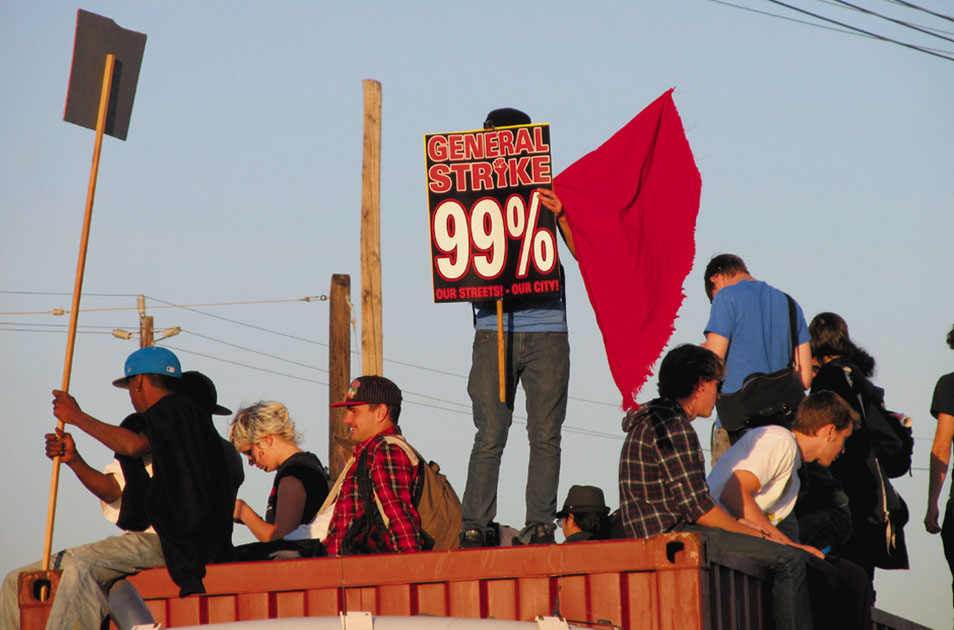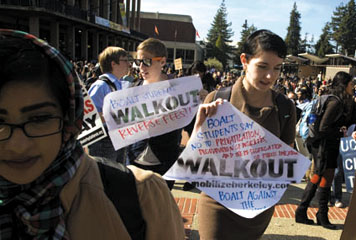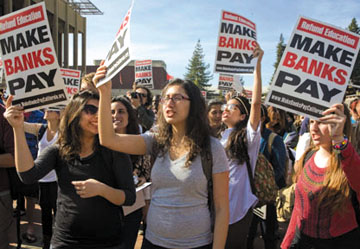
by Paul Rogat Loeb
[dropcap]T[/dropcap]he Occupy movement has done something amazing by getting Americans to start questioning our economic divides. It has created spaces for people to come together, voice their discontents and dreams, and creatively challenge destructive greed. It has created powerful political theater, engaged the community, and provided an alternative to silence and powerlessness.
But it also faces major challenges. I’m fine that this new public commons isn’t, as yet, offering detailed platforms for change. Instead, the movement has highlighted the destructive polarization of wealth while voicing what one young woman called “a cry for something better.” And that’s a major contribution.
The movement and its allies now need to keep spreading this message to that majority of Americans who are sympathetic but have given up on the possibility of change. The Occupy movement also needs to reach those more resistant, who might respond if seriously engaged.
It needs to make the physical occupations not just ends in themselves, but bases where more and more people can participate, and find ways to publicly act. To keep momentum building even in the winter cold, and when media coverage fades. To find continuing ways for people to act without dissipating their energy in an array of fragmented efforts. And, although some participants would disagree, to become part of a broader movement that, without muting its voice, helps bring about a better electoral outcome in 2012 than the disaster of 2010, when corporate interests prevailed again and again because those who would have rejected their lies stayed home.
One solution, which is beginning to happen, is for the movement to move to the neighborhoods, building on its existing efforts in hundreds of cities and towns. This doesn’t mean abandoning the current encampments. At their best, these occupations have created powerful new centers for conversation, reflection, and creative action. People talk, brainstorm ideas, make posters and banners, and draw in the curious, including those just passing by. In Seattle, even tourists riding the amphibious tour buses broke into cheers as they drove past the encampment.
Participants tell stories of lost jobs, medical bills, and student debt, putting a human face on how they and so many others have been made expendable by a country that seems to care only for the wealthiest.
Self-organized committees plan creative tactics, handle donations of food, address medical needs, create innovative art projects, clean the occupation grounds, and ensure physical security. Common meals become a form of communion.
The gatherings also convey a sense of festival, inviting in those not yet involved with puppets, colorful banners, drum circles, radical marching bands and signs saying, “I’ll believe corporations are people when Texas executes one.” People dress up as predatory billionaires, Lady Liberty and dollar-spewing zombies who chant, “I smell money, I smell money.”
The spirit of play echoes the defiant folk and hip hop music of Tahir Square and the Gandhi-meets-Monty-Python approaches of the Serbian youth movement Otpur, who helped train the initial Tahir Square occupiers.
But for all the value of creating visible protest communities in the centers of our cities, for all the powerful stories and Dadaist humor, most Americans are still watching from a distance as passive spectators. Those who care about these issues but aren’t ready to sleep on the hard, cold ground, could build on the opening that this movement has created to reach out to the rest of America.
It is a victory that the occupations have led the media to even briefly question America’s economic divisions. But it’s not one that we can count on indefinitely. So we need to find creative ways to take the key issues that the movement has placed on the agenda to every neighborhood, workplace and campus, even those that don’t seem natural hotbeds of change.
This could mean extending the existing protests to places they haven’t yet reached. Bank of America, Chase, Wells Fargo and Citibank branches are everywhere. So are Exxon/Mobil stations, symbols to challenge that corporation’s avoidance of taxes and massive funding of climate-change denial. So are the offices of regressive elected officials and candidates.
Harlem residents met at a local church to launch Occupy Harlem. In a Seattle neighborhood, activists criss-cross a major intersection every weekend holding banners and talking about the Iraq war and unaccountable corporate power. Seattle’s main Occupy encampment recently shifted from a downtown plaza to a community college a dozen blocks away, where their presence has grown to 150 tents and they’ve coexisted amicably with classes, campus events, and a weekend farmers market.
For the movement to make progress, it’s going to have to do more along these lines — not just hope that if they build enough tent cities and hold creative enough marches, change will come.
The people camping don’t have to be the same ones working in the neighborhoods. That may be a task best suited for long-standing activist organizations, whose participants have deeper local roots — organizations that might also help find resources to shelter the Occupiers in visible sympathetic churches or union halls as we head into winter.
If we’re to build on the powerful momentum that the occupations have created, we’re going to need to take the issues they’ve raised into face-to-face communities, like local businesses and churches, soccer leagues and Rotary clubs.
The occupations have played a powerful role in highlighting America’s profound economic disparities. But it’s up to us to take this message to all the diverse communities we ultimately need to reach.
We can’t trust capricious and compromised media outlets to adequately translate it, and relying on our own social media gives us far too narrow a reach. Fortunately, models exist for the kind of systematic grassroots outreach that could fuel the movement’s next stage. Here are a few models that might offer lessons:
Many of us went door-to-door during the 2008 Obama campaign. Most who participated soon lapsed into becoming passive spectators, and then retreated still further as cycles of disillusionment grew. Whatever Obama’s flaws, the one-to-one conversations people had while working to elect him were powerful, and we could begin to replicate them for a movement with goals larger than the platforms of any individual political leader or candidate.
One ongoing network to plug into is the AFL-CIO community organizing affiliate, Working America. Drawing on a mix of volunteers and paid canvassers, they’ve been reaching out in culturally conservative, working-class neighborhoods for the past eight years, focusing particularly on the unemployed. They talk with people about core economic issues, offer practical resource information and give ways to act on issues like unemployment benefits and investment in job-creating infrastructure.
By connecting previously isolated individuals with a broader engaged community, they both give them a voice and leave them far more resistant to greed-driven lies.
Since the economic crisis hit, the Boston community group City Life Vida Urbana began using official foreclosure lists to engage people at risk of losing their homes or apartments. They offer free legal advice as a way to encourage people to come to their meetings, then invite participants to join their protests at foreclosure auctions and at mortgage-holding banks, mustering enough public pressure to repeatedly force these institutions to write down loans that people owe.
Another fertile approach comes from Seattle peace activists. Shortly before the Iraq war, people from all over the region met in a large sympathetic church and divided themselves up by neighborhoods, including those in far-flung suburbs and smaller outlying cities. The local groups then met together to find ways to act in their specific communities, under the umbrella of what they called The Snow Coalition. Eight years later, many of these groups continue raising issues in contexts where people are more likely to know them as neighbors, coworkers, or friends.
The movements that brought us the New Deal in the Depression had a mix of local actions, intense community building (including powerful mutual aid institutions), and engagement in local and national politics — even as they remained independent enough to push Franklin Roosevelt to take his most powerful stands.
The civil rights movement mixed courageous direct action with door-to-door community organizing and voter registration, pushing an initially sympathetic but resistant Lyndon Johnson to put all his political skill into passing the Voting Rights and Civil Rights acts, even as he acknowledged that the Democrats would consequently “lose the South for a generation.”
The anti-Vietnam War movements started with small groups of people having the audacity to challenge their government, then began to make an impact when people in every community began to participate. All these past movements were able to successfully meld protest and witness with organizing.
If the Occupy movement is going to find a similarly fertile path as these movements, it’s going to have to let go of grandiose revolutionary dreams like the sentiments of a student who told me, “If we’re following the Arab Spring model we have to demand that all the politicians step down. Then Americans can meet and decide what to do.” Except that Egypt didn’t have real elections and we do, however compromised by wealth-driven lies.
So while the Occupiers need to maintain their independent voice, many of us will have to engage in messy electoral work to overcome the millions of dollars that will be pumped in for anonymous attack ads by people like Karl Rove, the Koch Brothers, the predatory banks, and oil and coal companies. If the Occupiers steer people away from electoral participation, they risk helping those at the top prevail even more.
That’s a real possibility, given the blanket dismissal of voting by far too many of the Occupy participants I’ve spoken with, or at least of voting within the two party system. The constantly repeated phrase “they’re all corrupt,” has its truths, but it also slams the courageous along with the compromised, and masks the major difference between politicians who disappoint us because we haven’t pressed them hard enough, and ones who’ve been doing their best to make the entire country and planet available for plunder.
If we want to avoid permanently enshrining the reign of the one percent, we might remember the Citizen’s United decision, where five Republican justices opened the floodgates for money to dominate politics as never before. If any of the current Republican candidates get to appoint one more justice, we’ll lock in similar decisions for the next 30 years.
We might also remember the Disclose Act, which would have at least required corporations and wealthy individuals to visibly put their names on ads and mailers that they funded. Every Democratic senator voted for it, even those most compromised with corporate dollars, but it fell one vote short when it couldn’t get a single Republican backer.
The result, combined with a massive drop-off from a disillusioned Democratic base, was a wave of anonymously funded attack ads that swung election after election, from legislative, Congressional and Senate seats to electing governors like Scott Walker, Rick Scott and John Kasich, who promptly disenfranchised voters, gutted education and social services, busted unions, stripped away environmental protections, and handed out ever-more massive tax breaks to the rich.
I’m not suggesting the Occupy movement subordinate itself to Obama, the Democrats, or any other party. Part of the tragedy of the past three years is that we didn’t have vital independent movements pushing both parties to deal with unemployment, foreclosures, and America’s massive economic divides. But nothing stops the Occupy movement from raising their key issues as clearly and powerfully as possible, while reminding people that showing up at the polls still matters.
The alternative is a revolutionary purism, where instead of registering voters like the Tea Party did, and reaching out to engage those on the fence, Occupy participants and their supporters stay home and hand the 2012 election to people who represent everything they loathe.
Like participants in previous movements for justice, the Occupiers need to avoid the false choices between protest and organizing, community building and electoral involvement, surrealist theater and the grunt work of change.
The criticisms they raise go beyond any single election, bill, or policy. They need to keep raising them, but in ways that keep spiraling out. If they can trigger enough conversations in communities as yet untouched by their voices, they have a chance to prevail. But they have to recognize that the powerful public presence they’ve created is just a beginning.
